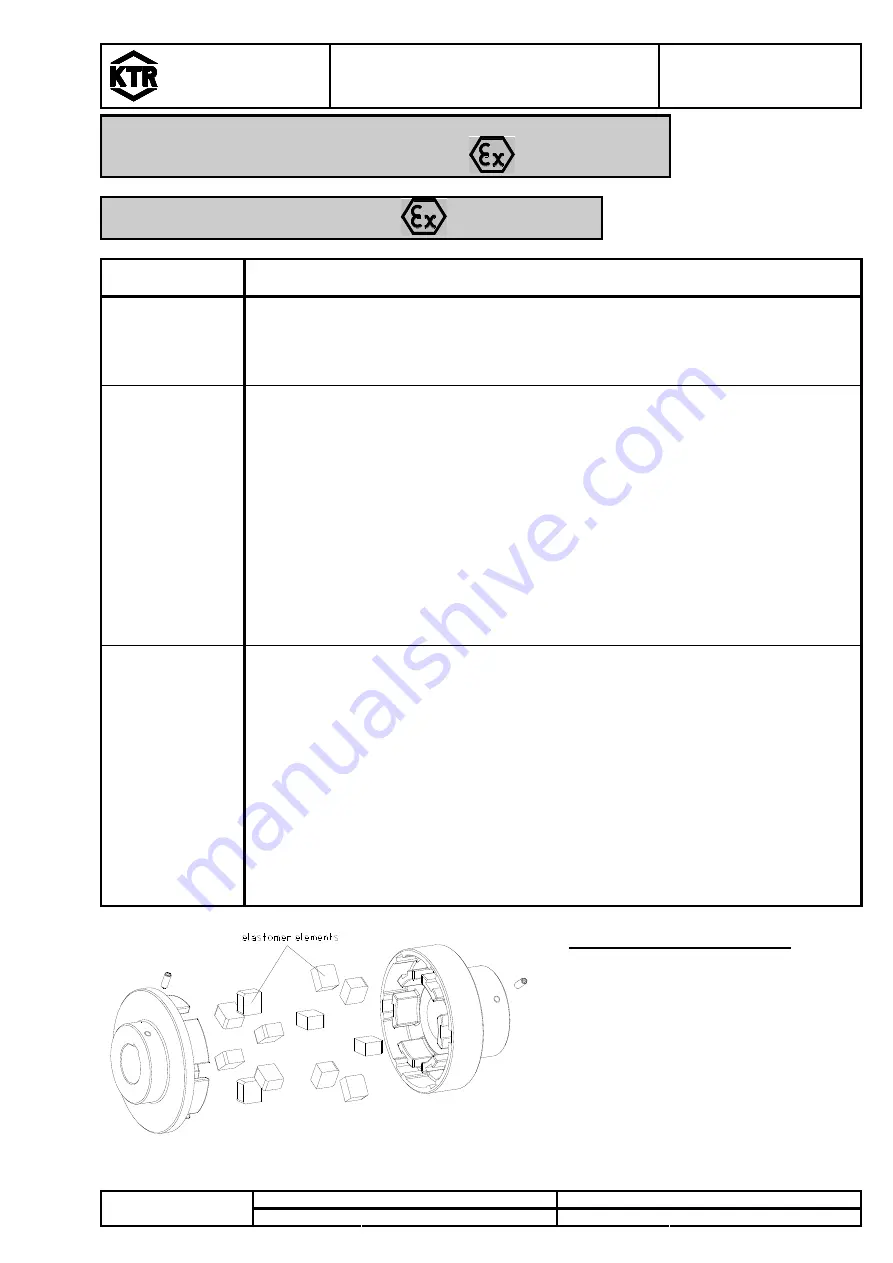
KTR Kupplungstechnik
GmbH
D-48407 Rheine
POLY
Operating-/Assembly Instructions
KTR-N
sheet:
edition:
49610 EN
17 of 24
9
Gezeichnet: 11.03.10
Pz/Bru
Ersatz für:
KTR-N vom 25.04.07
Schutzvermerk
ISO 16016 beachten. Geprüft:
16.03.10 Pz
Ersetzt durch:
5 Enclosure A
Hints and Instructions Regarding the Use in
Hazardous Areas
5.2 Control Intervals for Couplings in
Hazardous Areas
explosion group
control intervals
3G
3D
For couplings which are classified in category 3G or 3D the operating and assembly
instructions that are usual for standard operation apply. During the standard operation
which has to be subject to the analysis of danger of ignition the couplings are free from any
ignition source. Merely the temperature increase produced by proper heating and
depending on the coupling type has to be considered:
for POLY:
Δ
T = 20 K
II 2GD c IIB
T4, T5, T6
The torsional backlash of the coupling (see chapter 5.3) according to Guideline 94/9/EC
(ATEX 95) must only be controlled if a friction of the elastomer elements (part 2) and
consequently a machine down-time of the drive leads to explosion hazard.
A preventive checking of torsional backlash is recommended.
A checking of the circumferential backlash and a visual check of the elastomer elements
must be effected after 3,000 operating hours for the first time, after 6 months at the latest.
Except for centered, stiff connecting flanges (e. g. bellhousings).
If you note an unconsiderable or no wear at the elastomer elements after this first
inspection, the further inspections can be effected, in case of the same operating
parameters, respectively after 6,000 operating hours or after 18 months at the latest.
If you note a considerable wear during the first inspection, so that a change of the
elastomer elements would be recommended, please find out the cause according to the
table „Breakdowns“, as far as possible.
The maintenance intervals must be adjusted according to the changed operating
parameters.
II 2GD c IIC
T4, T5, T6
The torsional backlash of the coupling (see chapter 5.3) according to Guideline 94/9/EC
(ATEX 95) must only be controlled if a friction of the elastomer elements (part 2) and
consequently a machine down-time of the drive leads to explosion hazard.
A preventive checking of torsional backlash is recommended.
A checking of the circumferential backlash and a visual check of the elastomer elements
must be effected after 2,000 operating hours for the first time, after 3 months at the latest.
Except for centered, stiff connecting flanges (e. g. bellhousings).
If you note an unconsiderable or no wear at the elastomer elements after this first
inspection, the further inspections can be effected, in case of the same operating
parameters, respectively after 4,000 operating hours or after 12 months at the latest.
If you note a considerable wear during the first inspection, so that a change of the
elastomer elements would be recommended, please find out the cause according to the
table „Breakdowns“, as far as possible.
The maintenance intervals must be adjusted according to the changed operating
parameters.
picture 21: POLY type PKZ
Checking of torsional backlash
Here the backlash between coupling cams
and the elastomer elements must be
checked by reverse backlash.
The friction/wear may be 20 % of the
original thickness of the elastomer element
before exchanging the elastomer
elements. After having reached the limit of
wear
Δ
s
max.
the elastomer elements must
be exchanged immediately, irrespective of
the inspection intervals.








































